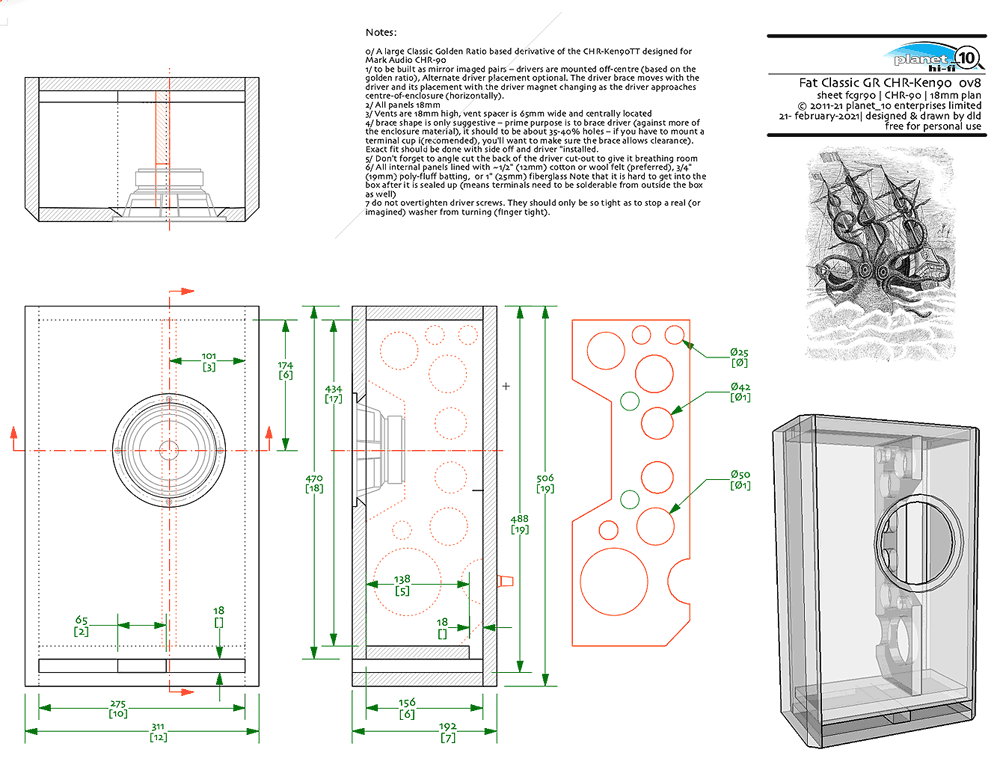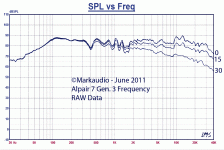I'd like the introduce the latest Markaudio full range driver - the CHR-90. Available in both Grey and Gold this new driver will suit many projects requiring a driver of this size. There will be several enclosure designs to whet the appetite of the DIYer soon. Keep you eye out here.
It has been mentioned here before but this is the first time it as available outside the of the east. It took a while due to Coronavirus and then Brexit to get them here.
Markaudio CHR-90 Full Range Speaker Driver | KJF Audio
It has been mentioned here before but this is the first time it as available outside the of the east. It took a while due to Coronavirus and then Brexit to get them here.
Markaudio CHR-90 Full Range Speaker Driver | KJF Audio
Looks nice but any reason why there are no off axis measurements provided and why the frequency plot is a 0-100dB rather than the usual 50-100sB scale ?
Mark audio never do off axis measurements which is just about standard fayre for wideband driver spec sheets.
Purely as a matter of factual data and interest, a rough list of average vertical scales that a variety of wideband drive unit manufacturers tend to use. There is some variation over time, so this should not be read as (nor intended to be) definitive:
In no particular order:
Fostex: 80dB
HiVi: 80dB
Tymphany (or whatever they are calling themselves on this day in history): Variable but typically 50dB
Aurasound: 70dB
Fountek: 100dB
MA: 100dB
SB: 60dB
Sica: 60dB
Audio Nirvana 100dB - 120dB
Lowther: 60dB
Beyma: 100dB
Supravox: about 80dB
PHY: (speaking under correction) about 100dB
Sonido: 50dB
Lii Audio: 100dB
Goldwood: 70dB
Visaton: 60dB
Omnes: depends who built it for them, roughly 60dB - 100dB
Lyeco: 70dB
Hartley: Nothing
Tang Band: 100dB
Dayton: 60dB
Celestion: 65dB
Gradient: 50dB
AER: 120dB
Eminence: 70dB
Cube: 120dB
Fertin: Nothing
Voxativ: typically few published FR plots although you can find some from the Ampeggio horn system
Feastrex: Nothing
By and large, most of the companies that use 50dB vertical scaling tend to be those who produce more conventional limited band drive units as well, for whom wideband are merely a side-issue or addition, and generally they standardise all their graphs to that. Not all, but a relatively common trend. Seas, Scan, Tymphany / Peerless / Vifa / whatever it is today are good examples of that. Wideband drive units rarely look particularly attractive on a graph of that size unless laterally stretched, which takes up space & is no more representative than a less laterally compressed graph at a larger vertical scale, so manufacturers tend to use something larger. Many who used LMS tended to let it select the default, which is why you'll also often see a rather oddly scaled logarithmic impedance plot.
In no particular order:
Fostex: 80dB
HiVi: 80dB
Tymphany (or whatever they are calling themselves on this day in history): Variable but typically 50dB
Aurasound: 70dB
Fountek: 100dB
MA: 100dB
SB: 60dB
Sica: 60dB
Audio Nirvana 100dB - 120dB
Lowther: 60dB
Beyma: 100dB
Supravox: about 80dB
PHY: (speaking under correction) about 100dB
Sonido: 50dB
Lii Audio: 100dB
Goldwood: 70dB
Visaton: 60dB
Omnes: depends who built it for them, roughly 60dB - 100dB
Lyeco: 70dB
Hartley: Nothing
Tang Band: 100dB
Dayton: 60dB
Celestion: 65dB
Gradient: 50dB
AER: 120dB
Eminence: 70dB
Cube: 120dB
Fertin: Nothing
Voxativ: typically few published FR plots although you can find some from the Ampeggio horn system
Feastrex: Nothing
By and large, most of the companies that use 50dB vertical scaling tend to be those who produce more conventional limited band drive units as well, for whom wideband are merely a side-issue or addition, and generally they standardise all their graphs to that. Not all, but a relatively common trend. Seas, Scan, Tymphany / Peerless / Vifa / whatever it is today are good examples of that. Wideband drive units rarely look particularly attractive on a graph of that size unless laterally stretched, which takes up space & is no more representative than a less laterally compressed graph at a larger vertical scale, so manufacturers tend to use something larger. Many who used LMS tended to let it select the default, which is why you'll also often see a rather oddly scaled logarithmic impedance plot.
Last edited:
Mark audio never do off axis measurements which is just about standard fayre for wideband driver spec sheets.
Interesting, it doesn't answer the question as to why though. I was under the impression off axis measurements of wideband drivers was of particular importance? They mention it's a "wide dispersion" driver without showing what they mean. Usually, with wideband drivers, a rising off axis response is desirable as it gives a better power response.
Last edited:
Does anyone else find it extremely odd that the grey version is about half the price of the gold?
Interesting, it doesn't answer the question as to why though. I was under the impression off axis measurements of wideband drivers was of particular importance? They mention it's a "wide dispersion" driver without showing what they mean. Usually, with wideband drivers, a rising off axis response is desirable as it gives a better power response.
The only ones who do it as far as i know are fostex and seas. And many brands of band limited speakers don't do it neighter. But i would also like to see more detailed specs, not only off axis measurements, but also DHT measurements of drivers.
But my experience with mark audio drivers is that their off axis response is rather good, there is not a big difference, and much less than Fostex, Tang band or Audio Nirvana have. I did not hear these altough, i only have experience with the Alpair 7.3, the Alpair 10.3, the Alpair 10P and the CHN110.
I can confirm good response with Pluvia 7HD and Sota 11R and a bit less with CHP70.2, but still ok
Yes. P7.2HD's rising top end makes for excellent off-axis response (for my ears). Incredibly detailed but not "in your face". This new CHR seems to have a similar rise just after 6-7k.
Last edited:
Sorry, I should have said rising on axis response, so they sound balanced listening off axis and give a good power response. Obviously it depends on the dispersion.
...both Grey and Gold...
Factory names? Ar ethey really the silve r& copper (haven’t seen either of the named colours since Gen 1.
dave
Mark audio never do off axis measurements which is just about standard fayre for wideband driver spec sheets.
Never say never. They have published official off-axis, but annoyingly not recently.
dave
Attachments
Does anyone else find it extremely odd that the grey version is about half the price of the gold?
I would find that extremely surprising. The only difference is colour.
dave
I'm going to be recording a little Zoom video with Mark Fenlon (Markaudio) this Tuesday about the new CHR-90 If anyone has any questions about the new driver, I would be glad to put some to him. I'll get it up on YouTube and post it here later in the week.
Well, you could thank Mark for producing an 89.36dBSPL 8Ω 5" driver that I would think should be compatible with single-digit SET amps.
Mark has with the CHN-110, CHR-90/120 increased the relative Vas so as to maintain bass extention and keep sensitivity up.
A 9slightly) smaller driver, essentially the same box and sensitivity as A10p yet goes lower (est 35 vrs 42 F10).

404 Error - Page Not Found (hopefully that works)
If anyone is interested in any of the other (potential) CHR-Kens for this, email me.
dave
A 9slightly) smaller driver, essentially the same box and sensitivity as A10p yet goes lower (est 35 vrs 42 F10).

404 Error - Page Not Found (hopefully that works)
If anyone is interested in any of the other (potential) CHR-Kens for this, email me.
dave
single-digit SET amps
Are there such? All the ones i have looked at have had bridged outputs.
dave
- Home
- Loudspeakers
- Full Range
- Markaudio CHR-90
